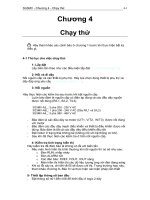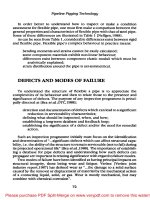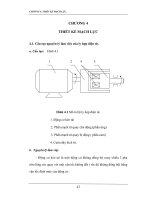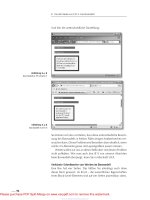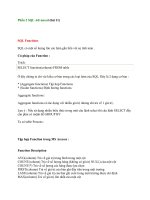Tài liệu SQL Puzzles & Answers- P4 ppt
Bạn đang xem bản rút gọn của tài liệu. Xem và tải ngay bản đầy đủ của tài liệu tại đây (368.27 KB, 40 trang )
102 PUZZLE 23 MAGAZINE
INSERT INTO Sales VALUES (2, 3, 3);
INSERT INTO Sales VALUES (3, 3, 3);
INSERT INTO Sales VALUES (4, 3, 1);
INSERT INTO Sales VALUES (5, 3, 1);
INSERT INTO Sales VALUES (6, 3, 3);
INSERT INTO Sales VALUES (7, 3, 3);
stand 4
INSERT INTO Sales VALUES (1, 4, 1);
INSERT INTO Sales VALUES (2, 4, 1);
INSERT INTO Sales VALUES (3, 4, 4);
INSERT INTO Sales VALUES (4, 4, 1);
INSERT INTO Sales VALUES (5, 4, 1);
INSERT INTO Sales VALUES (6, 4, 1);
INSERT INTO Sales VALUES (7, 4, 2);
SELECT stand_nbr
FROM (SELECT stand_nbr,
AVG(CASE WHEN title = 2667 THEN net_sold_qty
END),
AVG(CASE WHEN title = 48632 THEN net_sold_qty
END),
AVG(CASE WHEN title = 1107 THEN net_sold_qty
END) avg_1107
FROM Sales, Titles
WHERE Sales.product_id = Titles.product_id
GROUP BY stand_nbr
) AS T (stand_nbr, avg_2667, avg_48632, avg_1107)
WHERE avg_1107 > 5 OR (avg_2667 > 2 AND avg_48632 > 2);
A minor note: leaving off the ELSE NULL in a CASE expression is legal
shorthand, but I prefer to use it as a placeholder for future updates and
additions, as well as a reminder that a
NULL is being created.
Please purchase PDF Split-Merge on www.verypdf.com to remove this watermark.
PUZZLE 24 ONE IN TEN 103
PUZZLE
24 ONE IN TEN
Alan Flancman ran into a problem with some legacy system data that
had been moved over to an SQL database. The table looked like this:
CREATE TABLE MyTable
(keycol INTEGER NOT NULL,
f1 INTEGER NOT NULL,
f2 INTEGER NOT NULL,
f3 INTEGER NOT NULL,
f4 INTEGER NOT NULL,
f5 INTEGER NOT NULL,
f6 INTEGER NOT NULL,
f7 INTEGER NOT NULL,
f8 INTEGER NOT NULL,
f9 INTEGER NOT NULL,
f10 INTEGER NOT NULL);
The columns f1 through f10 were an attempt to flatten out an array
into a table. What he wanted was an elegant way to test against the
f1
through
f10 columns to find the rows that had exactly one nonzero
value in their columns.
How many different approaches can you find? We are looking for
variety and not performance.
Answer #1
You could use the SIGN() function in Sybase and other SQL products.
This function returns
-1, 0, or +1 if the argument is negative, zero, or
positive, respectively. Assuming that your numbers are zero or greater,
you simply write:
SELECT *
FROM MyTable
WHERE SIGN(f1) + SIGN(f2) + + SIGN(f10) = 1;
to find a single nonzero value. If you can have negative values, then make
the functions
SIGN(ABS(fn)).
Please purchase PDF Split-Merge on www.verypdf.com to remove this watermark.
104 PUZZLE 24 ONE IN TEN
The SIGN(ABS()) function combination can be written with the
CASE expression in SQL-92 as:
CASE WHEN x <> 0 THEN 1 ELSE 0 END
Answer #2
Since the fields are really an attempt to fake an array, you should put this
table into First Normal Form (1NF), like this:
CREATE TABLE Foobar
(keycol INTEGER NOT NULL,
i INTEGER NOT NULL CHECK (i BETWEEN 1 AND 10),
f INTEGER NOT NULL,
PRIMARY KEY (keycol, i));
The extra column i is really the subscript for the array. You now view
the problem as finding an entity that has exactly nine zero-valued
columns, instead of finding an entity that has exactly one nonzero-
valued
nonkey column. That is suddenly easy:
SELECT keycol
FROM Foobar
WHERE f = 0
GROUP BY keycol
HAVING COUNT(*) = 9;
You can create a VIEW that has the structure of Foobar, but things are
going to run pretty slowly unless you have a good optimizer:
CREATE VIEW Foobar (keycol, f)
AS SELECT keycol, f1 FROM MyTable WHERE f1 <> 0
UNION
SELECT keycol, f2 FROM MyTable WHERE f2 <> 0
UNION
UNION
SELECT keycol, f10 FROM MyTable WHERE f10 <> 0 ;
Please purchase PDF Split-Merge on www.verypdf.com to remove this watermark.
PUZZLE 24 ONE IN TEN 105
Answer #3
This depends on a feature of SQL-92 that is not generally available yet.
First, the code, then the explanation:
SELECT *
FROM MyTable
WHERE (f1, f2, , f10) IN
(VALUES (f1, 0, 0, 0, 0, 0, 0, 0, 0, 0),
(0, f2, 0, 0, 0, 0, 0, 0, 0, 0),
(0, 0, 0, 0, 0, 0, 0, 0, 0, f10))
AND (f1 + f2 + f10) > 0;
In SQL-92, you can use row and table constructors in comparison
predicates. The
IN predicate expands into a sequence of OR-ed equality
predicates. The row-wise version of equality is then done on a position-
by-position basis, where all corresponding values must be equal.
Answer #4
If one and only one column is nonzero, then there is a one set of nine
columns that are all zeros.
SELECT *
FROM MyTable
WHERE 0 IN
(VALUES (f2 + f3 + f10), pull out f1
(f1 + f3 + f10), pull out f2
(f1 + f2 + f9)) pull out f10
AND (f1 + f2 + f10) > 0;
Answer #5
In January 1999, Trevor Dwyer posted a similar problem he actually had
on CompuServe. The differences were that his table had
NULLs in it,
instead of zeros. His problem was the need to test for any number of
columns having a non-
NULL value. This is very easy in SQL-92:
Please purchase PDF Split-Merge on www.verypdf.com to remove this watermark.
106 PUZZLE 24 ONE IN TEN
SELECT *
FROM MyTable
WHERE COALESCE(f1, f2, f3, f4, f5, f6, f7, f8, f9, f10)
IS NOT NULL;
The COALESCE() function will return the first non-NULL it finds in the
list. If the entire list is made up of
NULLs, then it will return NULL.
Obviously, the original problem could be done by replacing each of
the column expressions in the list with a call to a conversion function:
COALESCE (NULLIF (f1, 0), NULLIF (f2, 0), , NULLIF (f10,
0))
Answer #6
Frédéric Brouard () came up with this answer:
SELECT *
FROM MyTable
WHERE
(f1+1)*(f2+1)*(f3+1)*(f4+1)*(f5+1)*(f6+1)*(f7+1)*(f8+1)*(f9
+1)*(f10+1)*(f2+1)= 2
Please purchase PDF Split-Merge on www.verypdf.com to remove this watermark.
PUZZLE 25 MILESTONE 107
PUZZLE
25 MILESTONE
This puzzle, in a slightly different form, came from Brian Young. His
system tracks a series of dates (milestones) for each particular type of
service (
service_type) that they sell on a particular order (my_order).
These dates constitute the schedule for the delivery of the service and
vary with the type of service they are delivering. Their management
would like to see a schedule for each shop horizontally, which I must
admit is a reasonable request, but it is really a job for the display
functions in the front end and not the database. They also want to be
able to specify which task code (
service_type) to display.
Brian ran across a clever solution to this problem by Steve Roti in an
SQL server book, but it relies on the
SUM function and a multiplication
by 1 to yield the correct result. (That Roti guy is very clever!)
Unfortunately, this technique doesn’t work with dates. So here is the
table structure:
CREATE TABLE ServicesSchedule
(shop_id CHAR(3) NOT NULL,
order_nbr CHAR(10) NOT NULL,
sch_seq INTEGER NOT NULL CHECK (sch_seq IN (1,2,3)),
service_type CHAR(2) NOT NULL,
sch_date DATE,
PRIMARY KEY (shop_id, order_nbr, sch_seq));
Where sch_seq is encoded as:
(1 = 'processed')
(2 = 'completed')
(3 = 'confirmed')
The data normally appears like this:
ServicesSchedule
shop_id order_nbr sch_seq service_type sch_date
==================================================
002 4155526710 1 01 '1994-07-16'
002 4155526710 2 01 '1994-07-30'
002 4155526710 3 01 '1994-10-01'
Please purchase PDF Split-Merge on www.verypdf.com to remove this watermark.
108 PUZZLE 25 MILESTONE
002 4155526711 1 01 '1994-07-16'
002 4155526711 2 01 '1994-07-30'
002 4155526711 3 01 NULL
This is the way they would like it to appear, assuming they want to
look at (
service_type = 01),
order_nbr processed completed confirmed
===================================================
4155526710 '1994-07-16' '1994-07-30' '1994-10-01'
4155526711 '1994-07-16' '1994-07-30' NULL
Answer #1
If you only have an SQL-89 product instead of an SQL-92, you can do
this with self-joins:
SELECT S0.order_nbr, S0.sch_date, S0.sch_date,
S1.sch_date, S2.sch_date, S3.sch_date
FROM ServicesSchedule AS S0, ServicesSchedule AS S1,
ServicesSchedule AS S2, ServicesSchedule AS S3
WHERE S0.service_type = :my_tos set task code
AND S0.order_nbr = :my_order set order_nbr
AND S1.order_nbr = S0.order_nbr AND S1.sch_seq = 1
AND S2.order_nbr = S0.order_nbr AND S2.sch_seq = 2
AND S3.order_nbr = S0.order_nbr AND S3.sch_seq = 3;
The problem is that for some SQL products, the self-joins are very
expensive. This is probably the fastest answer on the old SQL products.
Can you think of another way?
Answer #2
In SQL-92, this is easy and very fast with subquery expressions:
SELECT S0.order_nbr,
(SELECT sch_date
FROM ServicesSchedule AS S1
WHERE S1.sch_seq = 1
AND S1.order_nbr = S0.order_nbr) AS processed,
(SELECT sch_date
Please purchase PDF Split-Merge on www.verypdf.com to remove this watermark.
PUZZLE 25 MILESTONE 109
FROM ServicesSchedule AS S2
WHERE S2.sch_seq = 2
AND S2.order_nbr = S0.order_nbr) AS completed,
(SELECT sch_date
FROM ServicesSchedule AS S3
WHERE S3.sch_seq = 3
AND S3.order_nbr = S0.order_nbr) AS confirmed
FROM ServicesSchedule AS S0
WHERE service_type = :my_tos ; set task code
The trouble with this trick is that it might not be optimized in your
SQL. This can be worse than the self-join.
Answer #3
You could try using UNION ALL operators and a work table to flatten out
the original table. This is not usually a very good performer, but if the
original table is very large, it can sometimes beat the self-join used in
Answer #2.
INSERT INTO Work (order_nbr, processed, completed,
confirmed)
SELECT order_nbr, NULL, NULL, NULL
FROM ServicesSchedule AS S0
WHERE service_type = :my_tos set task code
UNION ALL
SELECT order_nbr, sch_date, NULL, NULL
FROM ServicesSchedule AS S1
WHERE S1.sch_seq = 1
AND S1.order_nbr = :my_order
AND service_type = :my_tos set task code
UNION ALL
SELECT order_nbr, NULL, sch_date, NULL
FROM ServicesSchedule AS S2
WHERE S2.sch_seq = 2
AND S2.order_nbr = :my_order
AND service_type = :my_tos set task code
UNION ALL
SELECT order_nbr, NULL, NULL, sch_date
FROM ServicesSchedule AS S3
WHERE S3.sch_seq = 3
Please purchase PDF Split-Merge on www.verypdf.com to remove this watermark.
110 PUZZLE 25 MILESTONE
AND S3.order_nbr = :my_order
AND service_type = :my_tos set task code
This simple UNION ALL statement might have to be broken down into
four
INSERTs. The final query is simply:
SELECT order_nbr, MAX(processed), MAX(completed),
MAX(confirmed)
FROM Work
GROUP BY order_nbr;
The MAX() function picks the highest non-NULL value in the group,
which also happens to be the only non-
NULL value in the group.
Answer #4
However, UNIONs can often be replaced by CASE expressions in SQL-92,
which leads us to this solution:
SELECT order_nbr,
(CASE WHEN sch_seq = 1
THEN sch_date
ELSE NULL END) AS processed,
(CASE WHEN sch_seq = 2
THEN sch_date END) AS
ELSE NULL END) AS completed,
(CASE WHEN sch_seq = 3
THEN sch_date
ELSE NULL END) AS confirmed
FROM ServicesSchedule
WHERE service_type = :my_tos
AND order_nbr = :my_order;
or you can try this same query with a GROUP BY clause:
SELECT order_nbr,
MAX(CASE WHEN sch_seq = 1 THEN sch_date ELSE NULL
END) AS processed,
MAX(CASE WHEN sch_seq = 2 THEN sch_date ELSE NULL
END) AS completed,
MAX(CASE WHEN sch_seq = 3 THEN sch_date ELSE NULL
END) AS confirmed
Please purchase PDF Split-Merge on www.verypdf.com to remove this watermark.
PUZZLE 25 MILESTONE 111
FROM ServicesSchedule
WHERE service_type=:my_tos
AND order_nbr= :my_order
GROUP BY order_nbr, service_type;
This is the preferred way in current SQL products, and now you can
translate old code into this template when you see it.
Please purchase PDF Split-Merge on www.verypdf.com to remove this watermark.
112 PUZZLE 26 DATAFLOW DIAGRAMS
PUZZLE
26 DATAFLOW DIAGRAMS
Tom Bragg posted a version of this problem on the CASE Forum on
CompuServe. You have a table of dataflow diagrams (DFDs), which has
the name of the diagram, the names of the bubbles in each diagram, and
the labels on the flow lines. It looks like this:
CREATE TABLE DataFlowDiagrams
(diagram_name CHAR(10) NOT NULL,
bubble_name CHAR(10) NOT NULL,
flow_name CHAR(10) NOT NULL,
PRIMARY KEY (diagram_name, bubble_name, flow_name));
To explain the problem, let’s use this table:
DataFlowDiagrams
diagram_name bubble_name flow_name
====================================
Proc1 input guesses
Proc1 input opinions
Proc1 crunch facts
Proc1 crunch guesses
Proc1 crunch opinions
Proc1 output facts
Proc1 output guesses
Proc2 reckon guesses
Proc2 reckon opinions
What we want to find is what flows do not go into each bubble within
the diagrams. This will be part of a diagram validation routine that will
search for missing dataflows. To make this easier, assume that all
bubbles should have all flows. This would mean that (
Proc1, input) is
missing the '
facts' flow, and that (Proc1, output) is missing the
'
opinions' flow.
Answer #1
We could use this SQL-92 query:
Please purchase PDF Split-Merge on www.verypdf.com to remove this watermark.
PUZZLE 26 DATAFLOW DIAGRAMS 113
SELECT F1.diagram_name, F1.bubble_name, F2.flow_name
FROM (SELECT F1.diagram_name, F1.bubble_name
FROM DataFlowDiagrams AS F1
CROSS JOIN
SELECT DISTINCT F2.flow_name
FROM DataFlowDiagrams AS F2)
EXCEPT
SELECT F3.diagram_name, F3.bubble_name, F3.flow_name
FROM DataFlowDiagrams AS F3;
Basically, it makes all possible combinations of diagrams and flows,
and then removes the ones we already have.
Answer #2
Another SQL-92 query would be:
SELECT F1.diagram_name, F1.bubble_name, F2.flow_name
FROM (SELECT F1.diagram_name, F1.bubble_name
FROM DataFlowDiagrams AS F1
CROSS JOIN
SELECT DISTINCT F2.flow_name
FROM DataFlowDiagrams AS F2
WHERE flow NOT IN (SELECT F3.flow_name
FROM DataFlowDiagrams AS F3
WHERE F3.diagram_name =
F1.diagram_name
AND F3.bubble_name =
F1.bubble_name)
ORDER BY F1.diagram_name, F1.bubble_name, F2.flow_name;
Answer #3
Or to answer the puzzle in SQL-89, you will need to use VIEWs:
build a set of all the flows
CREATE VIEW AllDFDFlows (flow_name)
AS SELECT DISTINCT flow_name FROM DataFlowDiagrams;
attach all the flows to each row of the original table
Please purchase PDF Split-Merge on www.verypdf.com to remove this watermark.
114 PUZZLE 26 DATAFLOW DIAGRAMS
CREATE VIEW NewDFD (diagram_name, bubble_name, flow_name,
missingflow)
AS SELECT DISTINCT F1.diagram_name, F1.bubble_name,
F1.flow, F2.flow_name
FROM DataFlowDiagrams AS F1, AllDFDFlows AS F2
WHERE F1.flow_name <> F2.flow_name;
Show me the (diagram_name, bubble_name) pairs and
missing flow
where the missing flow was not somewhere in the flow
column
of the pair.
SELECT DISTINCT diagram_name, bubble_name, missingflow
FROM NewDFD AS ND1
WHERE NOT EXISTS (SELECT *
FROM NewDFD AS ND2
WHERE ND1.diagram_name = ND2.diagram_name
AND ND1.bubble_name = ND2.bubble_name
AND ND1.flow = ND2.missingflow)
ORDER BY diagram_name, bubble_name, missingflow;
I probably overdid the DISTINCTs, but you can experiment with it for
execution speed. This should still run faster than moving all the rows
across the network.
Please purchase PDF Split-Merge on www.verypdf.com to remove this watermark.
PUZZLE 27 FINDING EQUAL SETS 115
PUZZLE
27 FINDING EQUAL SETS
Set theory has two symbols for subsets. One is a “horseshoe” on its side
(⊂), which means that set A is contained within set B and is sometimes
called a proper subset. The other is the same symbol with a horizontal
bar under it (⊆), which means “contained in or equal to,” which is
sometimes called just a subset or containment operator.
Standard SQL has never had an operator to compare tables against
each other. Several college textbooks on relational databases mention a
CONTAINS predicate that does not exist in standard SQL. Two such
offenders are An Introduction to Data Base Systems by Bipin C. Desai
(West Publishing, 1990, ISBN 0-314-66771-7) and Fundamentals of
Database Systems by Elmasri and Navthe (Benjamin Cummings, 1989,
ISBN 0-8053-0145-3). This predicate used to exist in the original System
R, IBM’s first experimental SQL system, but it was dropped from later
SQL implementations because of the expense of running it.
The
IN() predicate is a test for membership, not for subsets. For
those of you who remember your high school set theory, membership is
shown with a stylized epsilon with the containing set of the right side,
thus ∈. Membership is for one element, while a subset is itself a set, not
just an element.
Chris Date’s puzzle in the December 1993 issue of Database
Programming & Design magazine (“A Matter of Integrity, Part II”
According to Date, December 1993) was to use a supplier and parts table
to find pairs of suppliers who provide exactly the same parts. This is the
same thing as finding two equal sets. Given his famous table:
CREATE TABLE SupParts
(sno CHAR(2) NOT NULL,
pno CHAR(2) NOT NULL,
PRIMARY KEY (sno, pno));
How many ways can you find to do this problem?
Answer #1
One approach would be to do a FULL OUTER JOIN on each pair of
suppliers. Any parts that are not common to both would show up, but
would have generated
NULLs in one of the columns derived from the
supplier who was not in the
INNER JOIN portion. This tells you which
Please purchase PDF Split-Merge on www.verypdf.com to remove this watermark.
116 PUZZLE 27 FINDING EQUAL SETS
pairs are not matched, not who is. The final step is to remove these
nonmatching pairs from all possible pairs.
SELECT SP1.sno, SP2.sno
FROM SupParts AS SP1
INNER JOIN
SupParts AS SP2
ON SP1.pno = SP2.pno
AND SP1.sno < SP2.sno
EXCEPT
SELECT DISTINCT SP1.sno, SP2.sno
FROM SupParts AS SP1
FULL OUTER JOIN
SupParts AS SP2
ON SP1.pno = SP2.pno
AND SP1.sno < SP2.sno)
WHERE SP1.sno IS NULL
OR SP2.sno IS NULL;
This is probably going to run very slowly. The EXCEPT operator is the
SQL equivalent of set difference.
Answer #2
The usual way of proving that two sets are equal to each other is to show
that set A contains set B, and set B contains set A. What you would
usually do in standard SQL would be to show that there exists no
element in set A that is not in set B, and therefore A is a subset of B. So
the first attempt is usually something like this:
SELECT DISTINCT SP1.sno, SP2.sno
FROM SupParts AS SP1, SupParts AS SP2
WHERE SP1.sno < SP2.sno
AND SP1.pno IN (SELECT SP22.pno
FROM SupParts AS SP22
WHERE SP22.sno = SP2.sno)
AND SP2.pno IN (SELECT SP11.pno
FROM SupParts AS SP11
WHERE SP11.sno = SP1.sno));
Please purchase PDF Split-Merge on www.verypdf.com to remove this watermark.
PUZZLE 27 FINDING EQUAL SETS 117
Oops, this does not work because if a pair of suppliers has one item
in common, they will be returned.
Answer #3
You can use the NOT EXISTS predicate to imply the traditional test
mentioned in Answer #2.
SELECT DISTINCT SP1.sno, SP2.sno
FROM SupParts AS SP1, SupParts AS SP2
WHERE SP1.sno < SP2.sno
AND NOT EXISTS (SELECT SP3.pno part in SP1 but not in
SP2
FROM SupParts AS SP3
WHERE SP1.sno = SP3.sno
AND SP3.pno
NOT IN (SELECT pno
FROM SupParts AS SP4
WHERE SP2.sno = SP4.sno))
AND NOT EXISTS (SELECT SP5.pno part in SP2 but not in
SP1
FROM SupParts AS SP5
WHERE SP2.sno = SP5.sno
AND SP5.pno
NOT IN (SELECT pno
FROM SupParts AS SP4
WHERE SP1.sno = SP4.sno));
Answer #4
Instead of using subsets, I thought I would look for another way to do set
equality. First, I join one supplier to another on their common parts,
eliminating the situation where supplier 1 is the same as supplier 2, so
that I have the intersection of the two sets. If the intersection has the
same number of pairs as each of the two sets has elements, then the two
sets are equal.
SELECT SP1.sno, SP2.sno
FROM SupParts AS SP1
INNER JOIN
SupParts AS SP2
ON SP1.pno = SP2.pno
Please purchase PDF Split-Merge on www.verypdf.com to remove this watermark.
118 PUZZLE 27 FINDING EQUAL SETS
AND SP1.sno < SP2.sno
GROUP BY SP1.sno, SP2.sno
HAVING (SELECT COUNT(*) one to one mapping EXISTS
FROM SupParts AS SP3
WHERE SP3.sno = SP1.sno)
= (SELECT COUNT(*)
FROM SupParts AS SP4
WHERE SP4.sno = SP2.sno);
If there is an index on the supplier number in the SupParts table, it
can provide the counts directly as well as help with the join operation.
Answer #5
This is the same as Answer #4, but the GROUP BY has been replaced with
a
SELECT DISTINCT clause:
SELECT DISTINCT SP1.sno, SP2.sno
FROM (SupParts AS SP1
INNER JOIN
SupParts AS SP2
ON SP1.pno = SP2.pno
AND SP1.sno < SP2.sno)
WHERE (SELECT COUNT(*)
FROM SupParts AS SP3
WHERE SP3.sno = SP1.sno)
= (SELECT COUNT(*)
FROM SupParts AS SP4
WHERE SP4.sno = SP2.sno);
Answer #6
This is a version of Answer #3, from Francisco Moreno, which has the NOT
EXISTS
predicate replaced by set difference. He was using Oracle, and its
EXCEPT operator (called MINUS in their SQL dialect) is pretty fast.
SELECT DISTINCT SP1.sno, SP2.sno
FROM SupParts AS SP1, SupParts AS SP2
WHERE SP1.sno < SP2.sno
AND NOT EXISTS (SELECT SP3.pno part in SP1 but not in
SP2
FROM SupParts AS SP3
Please purchase PDF Split-Merge on www.verypdf.com to remove this watermark.
PUZZLE 27 FINDING EQUAL SETS 119
WHERE SP1.sno = SP3.sno
EXCEPT
SELECT SP4.pno
FROM SupParts AS SP4
WHERE SP2.sno = SP4.sno
AND NOT EXISTS (SELECT SP5.pno part in SP2 but notin
SP1
FROM SupParts AS SP5
WHERE SP2.sno = SP5.sno
EXCEPT
SELECT SP6.pno
FROM SupParts AS SP6
WHERE SP1.sno = SP6.sno);
Answer #7
Alexander Kuznetsov once more has a submission that improves the old
“counting matches in a join” approach:
SELECT A.sno, B.sno AS sno1
FROM (SELECT sno, COUNT(*), MIN(pno), MAX(pno)
FROM SubParts GROUP BY sno)
AS A(cnt, min_pno, max_pno)
INNER JOIN
(SELECT sno, COUNT(*), MIN(pno), MAX(pno)
FROM SubParts GROUP BY sno)
AS B(cnt, min_pno, max_pno)
four conditions filter out most permutations
ON A.cnt = B.cnt
AND A.min_pno = B.min_pno
AND A.max_pno = B.max_pno
AND A.sno < B.sno
Expensive inner select below does not have to execute for
every pair
WHERE A.cnt
= (SELECT COUNT(*)
FROM SubParts AS A1,
SubParts AS B1
WHERE A1.pno = B1.pno
AND A1.sno = A.sno
AND B1.sno = B.sno);
Please purchase PDF Split-Merge on www.verypdf.com to remove this watermark.
120 PUZZLE 27 FINDING EQUAL SETS
sn sn
=======
ab bb
aq pq
The clever part of this query is that most optimizers can quickly find
the
MIN() and MAX() values on a column because they are stored in the
statistics table.
Answer #8
Let’s look at notation and some of the usual tests for equality:
((A ⊆ B) = (B ⊆ A)) ⇒ (A = B)
((A ∪ B) = (B ∩ A)) ⇒ (A = B)
The first equation is really the basis for the comparisons that use
joins. The second equation is done at the set level rather than the subset
level, and it implies this answer:
SELECT DISTINCT ‘not equal’
FROM (SELECT * FROM A)
INTERSECT
SELECT * FROM B)
EXCEPT
(SELECT * FROM A)
UNION
SELECT * FROM B);
The idea is to return an empty set if tables A and B are equal. You
have to be careful about using the
ALL clauses on the set operators if
you have duplicates. The good news is that these operators work with
rows and not at the column level, so this template will generalize to
any pairs of union-compatible tables. You do not have to know the
column names.
Please purchase PDF Split-Merge on www.verypdf.com to remove this watermark.
PUZZLE 28 CALCULATE THE SINE FUNCTION 121
PUZZLE
28 CALCULATE THE SINE FUNCTION
Let’s assume that your SQL product does not have a sine function in its
standard library. Can you write a query that will calculate the sine of a
number in radians?
Answer #1
Just create a table with all the values you need:
CREATE TABLE Sine
(x REAL NOT NULL,
sin REAL NOT NULL);
INSERT INTO Sine
VALUES (0.00, 0.0000),
(0.75, 0.6816),
(0.76, 0.6889);
etc.
You can fill in this table with the help of a spreadsheet or a
programming language with a good math library. You can now use this
table in a scalar subquery:
(SELECT sin FROM Sine WHERE x = :myvalue)
Of course the table can get pretty big for some functions, but for
smaller functions with a limited range of argument values, this is not a
bad approach. The sine just happens to be a horrible choice since it is a
continuous function defined over all real numbers.
Answer #2
Did you notice that if :myvalue in the first answer was not in the table,
the subquery would be empty and hence return a
NULL? This is not good.
If you get out an old calculus or trigonometry book, you will find out
how your ancestors used tables in the days before there were calculators.
Please purchase PDF Split-Merge on www.verypdf.com to remove this watermark.
122 PUZZLE 28 CALCULATE THE SINE FUNCTION
They had a mathematical technique called interpolation, which came in
several flavors.
The easiest method is linear interpolation. Given two known values of
a function, f(a) and f(b), you can approximate a third value of the
function that lies between them. The formula is:
f(a) + (x-a) * ((f(b) - f(a))/ (b-a))
As an example, assume we want to find sin(0.754)
INSERT INTO Sine VALUES (0.75, 0.6816);
INSERT INTO Sine VALUES (0.76, 0.6889);
We plug in the formula and get:
0.6816 + (0.754 - 0.75) * ((0.6889 - 0.6816)/ (0.76-0.75))
= 0.68452
The actual answer is 0.68456, which means we are off by 0.00004,
and that is not bad for an estimate in most cases. The trick is to put it in
a query:
SELECT A.sin + (:myvalue - A.x)
* ((B.sin - A.sin)/ (B.x - A.x))
FROM Sine AS A, Sine AS B
WHERE A.x = (SELECT MAX(x) FROM Sine WHERE x <= :myvalue)
AND B.x = (SELECT MIN(x) FROM Sine WHERE x >= :myvalue);
You really need some more predicates to restrict the range of the
function between zero and two pi, but that is a minor detail. There are
other interpolation methods, but the idea is the same.
The lesson here is that SQL is a language designed to work with tables
and joins, not computations. You should look for a table solution before
you use a computational one. If you really want to get into the math
behind interpolation, I would suggest a copy of Interpolation by J. F.
Steffensen (Dover Publications, 2006, ISBN 0-486-45009-0).
Please purchase PDF Split-Merge on www.verypdf.com to remove this watermark.
PUZZLE 29 FIND THE MODE COMPUTATION 123
PUZZLE
29 FIND THE MODE COMPUTATION
The only descriptive statistical function in SQL is the simple average,
AVG(). While it is a common statistic, it is not the only one. The mean,
the median, and the mode are all ways of measuring “central tendency”
in a set of values. The mode is the most common value in a column in a
table. Let’s suppose that the table is named “Payroll” and has the
check_nbr number and the amount of each check_nbr.
CREATE TABLE Payroll
(check_nbr INTEGER NOT NULL PRIMARY KEY,
check_amt DECIMAL(8,2) NOT NULL,
);
What we want to see is the most common check amount and the
number of occurrences on the payroll. How would you write this query
in SQL-89? In SQL-92? In SQL-99?
Answer #1
SQL-89 lacks the orthogonality that SQL-92 has, so the best way is
probably to build a
VIEW first:
CREATE VIEW AmtCounts
AS SELECT COUNT(*) AS check_cnt
FROM Payroll
GROUP BY check_amt;
then use the VIEW to find the most frequent check_amt amount:
SELECT check_amt, COUNT(*)
FROM Payroll
GROUP BY check_amt
HAVING COUNT(*) = (SELECT MAX(check_cnt)
FROM AmtCounts);
But this solution leaves a VIEW lying around the database schema. If
you need it for something else, this is handy, but otherwise it is clutter. It
would be better to do this in one statement without
VIEWs.
Please purchase PDF Split-Merge on www.verypdf.com to remove this watermark.
124 PUZZLE 29 FIND THE MODE COMPUTATION
Answer #2
The orthogonality of SQL-92 will allow you to fold the VIEW into a
tabular subquery, thus:
SELECT check_amt, COUNT(*)AS check_cnt
FROM Payroll
GROUP BY check_amt
HAVING COUNT(*) = (SELECT MAX(check_cnt)
FROM (SELECT COUNT(*) AS check_cnt
FROM Payroll
GROUP BY check_amt));
The innermost SELECT statement has to be expanded completely
before it passes the grouped table to its immediate containing
SELECT
statement. That statement finds the
MAX() and then passes that single
number to the outermost
SELECT. There is a very good chance that the
grouped table will be destroyed in this process.
If the optimizer were smart, it would have saved the first query to
reuse in the final answer, but don’t bet on it. Let’s keep looking.
Answer #3
Here is another SQL-92 solution that will handle NULLs a bit differently
than the last solution; can you tell me what the differences are?
SELECT P0.check_amt, COUNT(*)AS check_cnt
FROM Payroll
GROUP BY check_amt
HAVING COUNT(*) >= ALL (SELECT COUNT(*) AS check_cnt
FROM Payroll
GROUP BY check_amt);
The possible advantage of this answer is that since no MAX() function
is used, there is a better chance that the grouped table will be preserved
from one
SELECT to be used by the other. Notice that the innermost
SELECT is a projection of the outermost SELECT.
You should try all three solutions to see how your particular SQL
implementation will perform with them.
Please purchase PDF Split-Merge on www.verypdf.com to remove this watermark.
PUZZLE 29 FIND THE MODE COMPUTATION 125
Answer #4
You will find that many of the current versions of SQL have a mode()
function in them now as part of the upcoming OLAP extensions, so this
is not much of a question anymore. We can effectively replace the
subquery with an OLAP function call.
SELECT check_amt,
COUNT(*)OVER (PARTITION BY check_amt)
AS check_cnt
FROM Payroll;
However, I do not know if there is any particular performance
advantage to this.
Please purchase PDF Split-Merge on www.verypdf.com to remove this watermark.
126 PUZZLE 30 AVERAGE SALES WAIT
PUZZLE
30 AVERAGE SALES WAIT
Raymond Petersen asked me the following question: Given a Sales table
with just the date of the sale and customer columns, is there any way to
calculate the average number of days between sales for each customer in
a single SQL statement? Use a simple table in which you can assume that
nobody makes a sale to the same person on the same day:
CREATE TABLE Sales
(customer_name CHAR(5) NOT NULL,
sale_date DATE NOT NULL,
PRIMARY KEY (customer_name, sale_date));
Let’s take a look at the date for the first week in June 1994:
Sales
customer_name sale_date
=========================
'Fred' '1994-06-01'
'Mary' '1994-06-01'
'Bill' '1994-06-01'
'Fred' '1994-06-02'
'Bill' '1994-06-02'
'Bill' '1994-06-03'
'Bill' '1994-06-04'
'Bill' '1994-06-05'
'Bill' '1994-06-06'
'Bill' '1994-06-07'
'Fred' '1994-06-07'
'Mary' '1994-06-08'
The data shows that Fred waited one day, then waited five days, for
an average of three days between his visits. Mary waited seven days, for
an average of seven days. Bill is a regular customer every day.
Answer #1
The first impulse is to construct an elaborate VIEW that shows the
number of days between each purchase for each customer. The first task
Please purchase PDF Split-Merge on www.verypdf.com to remove this watermark.
